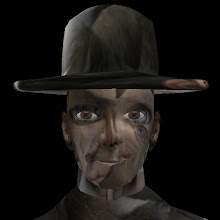I can't let today's meeting go without a blog post.
We had scheduled a project meeting in Second Life to discuss a few things, and the plan was for us all to meet and do voice. However, as is to be expected with these emergent technologies, all did not go to plan. Three of us could speak and hear, one of us could hear but not speak, and one of us could not hear, but could see what was being typed. Oh, what fun.
What I found fascinating was the range of complex, hybrid modes of communication that we all devised to manage this situation. On the face of it, the meeting was a technical disaster, but it was such an interesting - dare I say it - elegant and beautiful exploration of incorrect behaviour that I just find myself feeling really good about the whole experience.
The 'exploration of incorrect behaviour' is a phrase that caught my eye when I was re-reading Terry Mayes & Sara de Freitas e-Learning Models Desk Study* recently. It is something that is very familiar to us in art and design education. We actively encourage our students to take risks, make mistakes, and generally feel OK about messing it all up. Through reflection and analysis of the mess they create, we help them to recognise the unexpected opportunities that emerge. A positive re-evaluation of a seemingly disastrous experiment often leads to moments of pure clarity, as a solution to a completely different problem or a brand new line of inquiry becomes apparent.
So, my moment of clarity is this:
Voice is bad because of the 'satellite delay', which ruins the critical timing required for an effective conversation.
Text chat is bad because it is easy to misinterpret the tone of voice of the author, leading to paranoia.
Voice is good because it allows you to gauge the mood of the speaker.
Text chat is good because it gives you time to make a considered response, and can support multiple simultaneous threads.
Today, I enjoyed the bit when we were all typing, but we could hear the laughter over voice that reassured us that our words were being received in the spirit that they were intended. So, maybe voice in Second Life is best used as an augmentation of text chat. No one is allowed to speak proper sentences like in real life, but you can laugh, groan, tut, huff, maybe even the odd exclamation would be OK. No issues with timing. All the benefits of text. No need to switch from your fantasy character to the 'real you' if you don't want to. Less unfortunate misunderstandings.
Well, it's worth trying at some point.
It might be a disaster, but that fine. A positive re-evaluation of a seemingly disastrous experiment often leads to moments of pure clarity...
*http://www.essex.ac.uk/chimera/projects/JISC/Stage%202%20Implications%20for%20Evaluators%20(Version%201).pdf

No comments:
Post a Comment